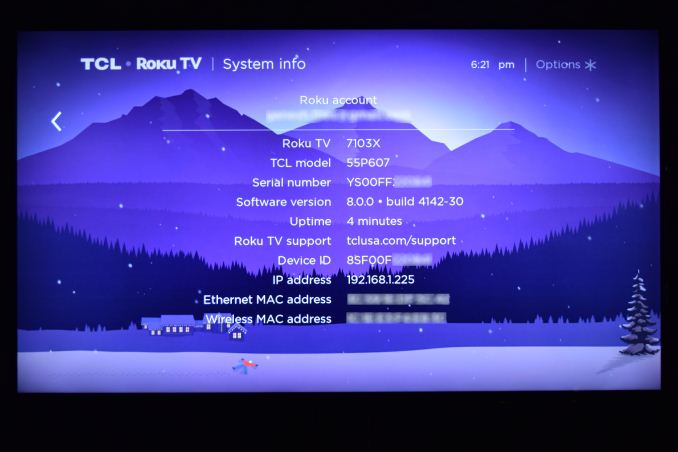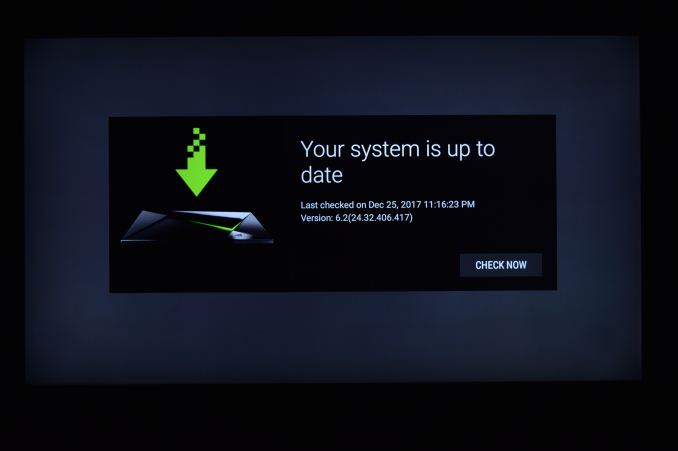A Budget Home Theater & PC Setup: 4K, HDR, UHD Blu-ray, and More
by Ganesh T S on December 26, 2017 8:30 AM ESTEvaluating Display Sources: HTPCs & CE Devices
Home Theater PCs used to be bulky versatile machines that had to support built-in TV tuners, a number of hard disks, as well as optical drives. However, the rising popularity of network TV tuners, network-attached storage (NAS) devices, and OTT streaming have resulted in the a transformation of the functionality that people expect from HTPCs. Simply put, a modern-day HTPC needs to be a flexible and versatile media player capable of handling a multitude of codecs and DRM requirements. The latter is not restricted to the handling of the encoded video. The display output also needs to be secure, while providing enough bandwidth and features to take full advantage of the capabilities of the downstream devices in the setup.
The average consumer often finds the 'it just works' nature of consumer electronic (CE) equipment such as the Roku streamers, game consoles, and standalone Blu-ray players to be attractive. However, for power users, the flexibility of HTPCs (such as the ability to support arcane subtitle formats or specific container features such as MKV chapters, or, even serve as a gaming machine) is simply too much to give up. Certain CE devices such as the NVIDIA SHIELD Android TV STB attempt to offer the best of both worlds. However, they are still closed platforms, and often do not have enough horsepower to fall back upon software decode for unsupported codecs.
Despite my predilection for HTPCs, I wanted to bring out the pros and cons of other closed solutions. Towards this, the evaluation of various options for media playback / display sources addresses the following aspects:
- HDR Support
- OTT Streaming (YouTube and Netflix)
- Local Media Playback (via USB)
- UHD Blu-ray Playback with HDR
The first candidate is the TCL 55P607's built-in Roku platform. Our tests were processed with the TV connected to the network using its wired 10 / 100 Mbps interface and Wi-Fi disabled. Firmware version 8.0.0 4142-30 was used.
The second solution in our evaluation set is one of the most popular Android TV STBs in the market - the NVIDIA SHIELD Android TV (SATV). Despite having launched back in 2015, the combination of high-end hardware and regular firmware updates have kept it at the top of the media player / Android TV STB market. Our tests were processed with the SHEILD connected to the network using its wired 1 Gbps interface and Wi-Fi disabled. Firmware version 6.2 was used.
The use of a RF remote / controller, combined with IP control using a smartphone app, mean that the SHIELD can be safely tucked away out of sight in a home theater setup.
Moving on to the HTPC front, we have three different PCs, with configurations and driver versions listed in the table below.
| Compact Home Theater PC Candidates - 2017 | |||
| PC | Zotac ZBOX MAGNUS EN1080K | ASRock Beebox-S 7200U | Intel NUC7i7BNHX1 |
| CPU | Intel Core i7-7700 | Intel Core i5-7200U | Intel Core i7-7567U |
| GPU | NVIDIA GTX 1080 (8GB GDDR5X) | Intel HD Graphics 620 | Intel Iris Graphics 650 |
| RAM | Corsair Vengeance 2x16GB DDR4-2667 SODIMM | Micron 16ATF1G64HZ 2x8GB DDR4-2133 SODIMM | Crucial Ballistix Sport LT 2x16GB DDR4-2400 SODIMM |
| Storage | Toshiba OCZ RD400 (512GB) | Kingston SSD Now V+ SNV325S2 (128GB) | Samsung SSD 840 EVO (500GB) + Intel Optane (16GB) |
| BIOS | 2K170814 | 1.73 | BNKBL357.86A.0054 |
| GPU Driver | 388.31 | 4877+ (beta) | 4877+ (beta) |
| Specifications | Zotac ZBOX MAGNUS EN1080K Specifications | ASRock Beebox-S 7200U Specifications | Intel NUC7i7BNHX1 Specifications |
| Pricing (NOT as configured) | USD 2000 (with 120GB SSD, 1TB HDD, 8GB RAM, and Windows 10) | USD 349 (Barebones) | USD 506 (Barebones) |
Note that we are using a beta driver from Intel that will be released to the public in January 2018. The reason behind the use of this driver will be apparent in our UHD Blu-ray Playback section.
Windows 10 Fall Creators Update was used as the OS for all the tests done using the above PCs. This version is critical for cutting-edge HTPC functionality, as it brings HDR desktop and media payback support into the stable release channel.













191 Comments
View All Comments
Azethoth - Monday, January 1, 2018 - link
Why don't you go read an article on _not_ home theater, and regale everyone with how awesome the sound from your shitty TV speakers are. Home theater is simply not for your budget, but don't pretend everyone is living in mom's basement.This article may be out of touch with the 5 of you, but it is not out of touch with the rest of the readers.
Why not go whine in articles about supercars about how they are out of touch with 99.999999% of the planet. Oh noes! I still want to read about them though.
Sivar - Wednesday, January 3, 2018 - link
Most Anandtech readers are tech-savvy, but not tech experts and have normal homes, eyes, ears, and middle-level income (of those in the United States).Talk of an OLED TV or projector tells me that it is you who is out of touch with readers, and it doesn't help that your statement to the author was inappropriately rude.
OLED TVs have an objectively better picture quality, but are much more expensive and the difference is not that noticeable to most people.
Projectors are great (I use one) but are impractical for many (most?) homes because they need light control and, for good pricing, a large flat wall for the screen.
Regarding speakers, if the implication is that there is no noticeable difference between them, then yI suspect you are not at all an enthusiast of home theater. This isn't even a reasonable debate, it just leaves me dumbfounded. True that there is little difference between an extremely fancy speakers (say from Focal or Magico) and a good set of well-designed towers such as those from Ascend or JBL, and indeed the audio industry has a lot of snake oil like expensive cables and any Bose product, but to say that a speaker "works or it doesn't" proves little experience with sound systems, even in the sub-$500 range.
SunnyHours - Wednesday, July 11, 2018 - link
Totally agree with you there!Especially your comment about Cables, Bose (I HATE BOSE!) and mostly the comment that "either a speaker works or it doesn't" that just really surprised me and made me wonder how this person can even entertain the idea of giving tips on a subject you know nothing about...especially on the internet where people will put you on the spot and call you for being an ignorant person and at the same time being a "know it all".
Next thing he will say is that "Vinyls sound like crap and cassettes were a much improved product" LOL.
Dug - Friday, January 5, 2018 - link
He's not out of touch. A good balanced receiver will last much longer in a system than video. Most people upgrade video (tv's, monitors, etc), than they do sound. Projectors don't really fall into the family room scenario either. Usually too much light, sound, maintenance, setup, etc. Plus there's no real 4k hdr affordable projectors out.Bullwinkle-J-Moose - Thursday, December 28, 2017 - link
"So you want a home theater system but don't want to get an AV receiver?"-----------------------------------------------------------------------------------------------------
Why not?
I have a 35 Watt dual-core Sandy Bridge with optical audio output to my Digital EQ (Behringer DEQ24/96) and Balanced XLR to each JBL LSR305 powered monitor
(Behinger AD converters sound like crap but with an optical input, it sounds Fantastical)
Much better than a Denon receiver I do believe
Sure, it's completely Gimped when its running Windows 10 DRM garbage
But, if I want to run 4K on a Gimped System, I can boot to 7 / 8.1 or Spyware Platform 10
I'm running Windows XP right now so I don't need to worry about Bluescreens of Death, malware, or Viruses like I do with Spyware 10
Burns BlueRay Disks fine and can boot to a stock install of XP in 3-4 seconds from a Samsung 850 Pro
Any computer newer than Sandy Bridge is nothing more than a Locked Down Gaming Console with a web browser attached and they make for really piss poor home theater setups
"Personal" Computers died with Sandy Bridge!
You are just renting a JukeBox
Azethoth - Monday, January 1, 2018 - link
I am missing the part where your "fantastical" Behringer DEQ24/96 decodes Dolby Surround.You are failing at Home Theater. There are standards. One of them is surround sound.
Stereo is for listening to old timey music. I am willing to put my Denon in surround stereo up against your stereo thing anytime. I will also pretend that Denon is better, except it would actually be true unlike your imaginings where an optical in somehow makes a difference.
Just so you know, hard science and engineering tells us that an optical in connection means you 100% do not have what this article is about: the more part of 4k blu ray. Atmos does not fit into optical. Hell, 7.1 and 9.1 surround did not fit.
So you and the rest here are just bloviating without saying anything relevant to the topic.
tl;dr If it is beyond your budget, quit whining and read the follow up article next year. Everything will be cheaper and better.
Bullwinkle-J-Moose - Monday, January 1, 2018 - link
"I am missing the part where your "fantastical" Behringer DEQ24/96 decodes Dolby Surround.You are failing at Home Theater. There are standards. One of them is surround sound."
--------------------------------------------------------------------------------------------------------------------
There is no "Standard" to Home Theater!
Surround Sound is one of many so called "Standards"
Your "Budget" demands "Your Standards"
3.1 / 5.1 / 7.1 / 9.1 are simply additions to the 3.0 "Standard" that I created over 30 years ago
They do not Image a "Standard" stereo output as well as mine and yet you claim "They" are the "Standard"
Advertising propaganda has taught you well
Now go forth and spew nonsense
A "Budget" Home Theater can be whatever you want it to be
Racing Stripes and RGB lighting may cost extra
Reflex - Monday, January 1, 2018 - link
I am unclear on how your setup will do positional audio in a home theater setup. For instance, if I play back DD5.1 content, will your setup put the appropriate audio and effects behind a viewer? If I play Dolby Atmos or DTS X content, will it additionally place the appropriate audio above the viewer's head? If so, how are you handling the decode operation for those standards to translate them to your proprietary speaker number and arrangement?Thanks!
Bullwinkle-J-Moose - Tuesday, January 2, 2018 - link
"If I play Dolby Atmos or DTS X content, will it additionally place the appropriate audio above the viewer's head? If so, how are you handling the decode operation for those standards to translate them to your proprietary speaker number and arrangement?"-------------------------------------------------------------------------------
I support my original "Reference Standard" which preceded Atmos and DTS X
I do not support other "Non-Standards" which came later
The only way a "Non-Standard" Home Theater experience can match the "Stereo" Imaging accuracy of my Reference "Standard" is to steal my design
If Dolby or anyone else can claim to match the Imaging accuracy of my Reference Design, then there are really only two possibilities here that I can see
A: They stole my design
or
B: They are Liars
There either ONE Reference, or there is no reference
Choose Now!
Bullwinkle-J-Moose - Tuesday, January 2, 2018 - link
There is either ONE Reference, or there is no reference at all